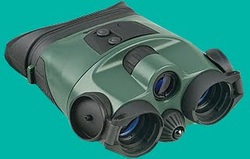Night Vision Devices

Night vision devices are optical implements which allow the wearer to see objects in their immediate field of vision, despite an almost complete lack of visible light. The most common use for these instruments is within the military or law enforcement fields, however the devices are also sold to regular civilian consumers. Generally, these devices are based in designs similar to standard binoculars, though they often feature head gear which allows for hands free use. Often times, these instruments are spoken of as the abbreviation NVD, however in some circles, they are referred to as night optical devices, also known as NODs.
First developed for use during World War 2, night vision devices changed the tactical landscape in regard to night time skirmishes. They added an additional level of stealth and greatly improved the safety of troops at night. Due to those positive attributes, night vision devices were used in a widespread fashion by the time the Vietnam War came to pass. Due to technological advancement, the most recent models of night vision goggles, and otherwise, have superior performance despite the fact that they are now far less expensive to produce than in the past.
Night vision devices, or night vision goggles as they have come to be known in popular culture, are generally referred to as an entire unit which has features such as an image intensifier tube, a durable housing unit to protect the intricate inner workings, along with the earlier mentioned head gear mount. Many of the instruments come with options like telescopic lenses, and light intensifiers.
Dr. Vladimir K. Zworykin was behind the development of the first practical night vision system which could be sold commercially. His invention was an effort for use by civilians. Unfortunately, due to issues stemming from price and size, the device flopped on the market. 1935 saw the first devices developed for military use, and by 1939 the Germans were taking full advantage of this new technology.
United States government and manufacturers abide by a specific classification system which breaks down the individual generations of night vision utilities into separate standards. Beginning with Generation 0, the classification moves on to Generations 2, and 3, at which point the Omnibus-VII comes in to play. The Omnibus-VII generation is technically the fourth generation of night vision devices developed, however the U.S. government has not officially acknowledged it as such.
First developed for use during World War 2, night vision devices changed the tactical landscape in regard to night time skirmishes. They added an additional level of stealth and greatly improved the safety of troops at night. Due to those positive attributes, night vision devices were used in a widespread fashion by the time the Vietnam War came to pass. Due to technological advancement, the most recent models of night vision goggles, and otherwise, have superior performance despite the fact that they are now far less expensive to produce than in the past.
Night vision devices, or night vision goggles as they have come to be known in popular culture, are generally referred to as an entire unit which has features such as an image intensifier tube, a durable housing unit to protect the intricate inner workings, along with the earlier mentioned head gear mount. Many of the instruments come with options like telescopic lenses, and light intensifiers.
Dr. Vladimir K. Zworykin was behind the development of the first practical night vision system which could be sold commercially. His invention was an effort for use by civilians. Unfortunately, due to issues stemming from price and size, the device flopped on the market. 1935 saw the first devices developed for military use, and by 1939 the Germans were taking full advantage of this new technology.
United States government and manufacturers abide by a specific classification system which breaks down the individual generations of night vision utilities into separate standards. Beginning with Generation 0, the classification moves on to Generations 2, and 3, at which point the Omnibus-VII comes in to play. The Omnibus-VII generation is technically the fourth generation of night vision devices developed, however the U.S. government has not officially acknowledged it as such.